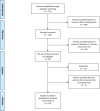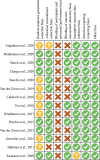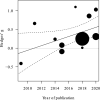A meta-analysis on heart rate variability biofeedback and depressive symptoms
- PMID: 33758260
- PMCID: PMC7988005
- DOI: 10.1038/s41598-021-86149-7
A meta-analysis on heart rate variability biofeedback and depressive symptoms
Abstract
Heart rate variability biofeedback (HRVB) has been used for a number of years to treat depressive symptoms, a common mental health issue, which is often comorbid with other psychopathological and medical conditions. The aim of the present meta-analysis is to test whether and to what extent HRVB is effective in reducing depressive symptoms in adult patients. We conducted a literature search on Pubmed, ProQuest, Ovid PsycInfo, and Embase up to October 2020, and identified 721 studies. Fourteen studies were included in the meta-analysis. Three meta-regressions were also performed to further test whether publication year, the questionnaire used to assess depressive symptoms, or the interval of time between T0 and T1 moderated the effect of HRVB. Overall, we analysed 14 RCTs with a total of 794 participants. The random effect analysis yielded a medium mean effect size g = 0.38 [95% CI = 0.16, 0.60; 95% PI = - 0.19, 0.96], z = 3.44, p = 0.0006. The total heterogeneity was significant, QT = 23.49, p = 0.03, I2 = 45%, which suggested a moderate variance among the included studies. The year of publication (χ2(1) = 4.08, p = 0.04) and the questionnaire used to assess symptoms (χ2(4) = 12.65, p = 0.01) significantly moderated the effect of the interventions and reduced heterogeneity. Overall, results showed that HRVB improves depressive symptoms in several psychophysiological conditions in adult samples and should be considered as a valid technique to increase psychological well-being.
Conflict of interest statement
The authors declare no competing interests.
Figures





Similar articles
-
A meta-analysis investigating the outcomes and correlation between heart rate variability biofeedback training on depressive symptoms and heart rate variability outcomes versus standard treatment in comorbid adult populations.Acta Biomed. 2023 Aug 3;94(4):e2023214. doi: 10.23750/abm.v94i4.14305. Acta Biomed. 2023. PMID: 37539604 Free PMC article. Review.
-
Adding HRV biofeedback to psychotherapy increases heart rate variability and improves the treatment of major depressive disorder.Int J Psychophysiol. 2018 Sep;131:96-101. doi: 10.1016/j.ijpsycho.2018.01.001. Epub 2018 Jan 5. Int J Psychophysiol. 2018. PMID: 29307738
-
Heart Rate Variability Biofeedback as a Treatment for Military PTSD: A Meta-Analysis.Mil Med. 2024 Aug 30;189(9-10):e1903-e1909. doi: 10.1093/milmed/usae003. Mil Med. 2024. PMID: 38287778
-
Heart Rate Variability Biofeedback Improves Emotional and Physical Health and Performance: A Systematic Review and Meta Analysis.Appl Psychophysiol Biofeedback. 2020 Sep;45(3):109-129. doi: 10.1007/s10484-020-09466-z. Appl Psychophysiol Biofeedback. 2020. PMID: 32385728
-
Real-time heart rate variability biofeedback amplitude during a large-scale digital mental health intervention differed by age, gender, and mental and physical health.Psychophysiology. 2024 Jun;61(6):e14533. doi: 10.1111/psyp.14533. Epub 2024 Mar 7. Psychophysiology. 2024. PMID: 38454612
Cited by
-
Effect of Various Lengths of Respiration on Heart Rate Variability during Simple Bhramari (Humming).Int J Yoga. 2023 May-Aug;16(2):123-131. doi: 10.4103/ijoy.ijoy_113_23. Epub 2023 Nov 21. Int J Yoga. 2023. PMID: 38204770 Free PMC article.
-
Modern Methods of Diagnostics and Treatment of Neurodegenerative Diseases and Depression.Diagnostics (Basel). 2023 Feb 3;13(3):573. doi: 10.3390/diagnostics13030573. Diagnostics (Basel). 2023. PMID: 36766678 Free PMC article. Review.
-
Sports Performance and Breathing Rate: What Is the Connection? A Narrative Review on Breathing Strategies.Sports (Basel). 2023 May 10;11(5):103. doi: 10.3390/sports11050103. Sports (Basel). 2023. PMID: 37234059 Free PMC article. Review.
-
Impact of Sudden Cardiac Arrest and Implantable Cardiac Defibrillator Shocks on Mental Health: Review and Management Guidance.JACC Adv. 2025 Jun;4(6 Pt 1):101797. doi: 10.1016/j.jacadv.2025.101797. Epub 2025 May 14. JACC Adv. 2025. PMID: 40373523 Free PMC article.
-
Unveiling the therapeutic potential of the gut microbiota-brain axis: Novel insights and clinical applications in neurological disorders.Medicine (Baltimore). 2025 Jul 25;104(30):e43542. doi: 10.1097/MD.0000000000043542. Medicine (Baltimore). 2025. PMID: 40725913 Free PMC article. Review.
References
-
- World Health Organization . Depression and Other Common Mental Disorders Global Health Estimates. WHO; 2017.
Publication types
MeSH terms
LinkOut - more resources
Full Text Sources
Other Literature Sources
Medical
Research Materials
Miscellaneous

